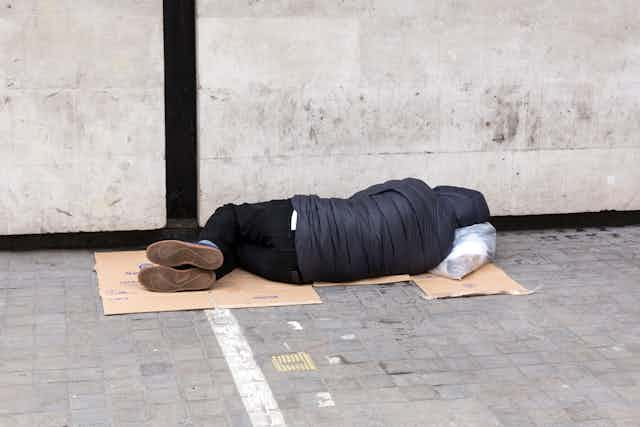The UK government is consulting on plans to stop publishing vital statistics from the Office for National Statistics (ONS) on deaths of homeless people. This is part of a wider review of mortality statistics including deaths in care homes and winter mortality.
Since 2018, the ONS in England and Wales and the National Records for Scotland (NRS) have published annual reports about the deaths of homeless people. This data offers insights into year-on-year changes in recorded deaths, including details about sex, age and cause of death. (There are plans to collate similar official data in Northern Ireland, but none has yet been published.)
The UK government claims that these statistics are “experimental” and that “further development work” is needed to bring them up to “national statistics status”. As part of its consultation, which closes on March 5 2024, the government is looking for feedback on “the relative importance” of these statistics.
Our research shows that death is a constant threat for people experiencing homelessness. However, this is rarely considered, by the public or by politicians, as part of the plight of being unhoused.

Invisible in life and death
Globally, homeless populations are three-to-four times more likely to die than the general population. Homelessness and health expert James J. O’Connell has said that despite the diverse methodologies different institutions across the world use to measure homelessness-related mortality, there is a “remarkable consistency” in death rates internationally – one that “transcends borders, cultures and oceans”.
Research shows that homeless adults and children are more likely to suffer underlying health conditions than the general population. Unhoused people are disproportionately likely to die due to violent accidents, such as being run over by a motor vehicle, or being crushed in a bin lorry.
Until 2018, the UK government did not track the number of people dying while homeless. Only when the Bureau of Investigative Journalism and journalist Maeve McClenaghan, working with London-based group The Museum of Homelessness, revealed the profound invisibility of this precise issue as part of their Dying Homeless project, did the ONS in England and Wales and the NRS begin to tackle it.
To date, their data is the most accurate official data on homelessness-related deaths in the UK. It is, however, imperfect – the ONS recognises as much, and advises caution in how it is interpreted.
These data limitations include the unreliability of coroners’ reports, which do not always record the fact that the deceased was homeless. This might be due to incomplete information given to the registrar, or out of consideration for the person’s family.
There is also no specific question on a death certificate to ask if a person was homeless at the time of death. Instead, the ONS must search death certificate data for registered addresses specified as “no fixed abode” or that are of a known hostel. And the ONS does not yet have a comprehensive list of all homeless hostels and emergency shelters, although such a list is now in development.

Why this matters
The absence of data concerning homeless populations is not a new phenomenon. It underlines the wider invisibility from which unhoused people suffer.
The way people sleeping rough are counted involves less-than-perfect methods. In 2022, 80% of local authorities in England gauged numbers of rough sleepers using an “evidence-based estimate meeting”. This involves local agencies (such as charities, outreach teams and homelessness accommodation services) giving an informed estimate of how many people might be sleeping rough on a typical night. Only 20% of local authorities actually counted the people they saw sleeping rough.
And of course, homelessness covers more than rough sleeping. Statutory homelessness refers to people to whom local authorities owe either a main duty to house or a relief duty, whereby they work with applicants to attempt to prevent or relieve homelessness (for example, by developing a personalised plan to support an applicant).
Research shows the tools used to measure and assess homelessness and rough sleeping vastly underestimate how extensive it is. People who are not eligible for statutory support are not counted.
Further, not all homeless people will present themselves to local authorities, as some people – often referred to as the “hidden homeless” – are put off from applying because of fears of being rejected. As data on statutory homelessness is compiled based on these applications, many homeless adults and children are excluded from official statistics.
Health researchers argue that homelessness presents a public health crisis. Gauging the extent of it – by publishing official statistics on the number of people who die while homeless – is the first step in combating it.
At a time when evictions are rising and the affordable housebuilding system is set to all but collapse, deaths of homeless people is a critical political issue. The UK government needs to take responsibility for it.

